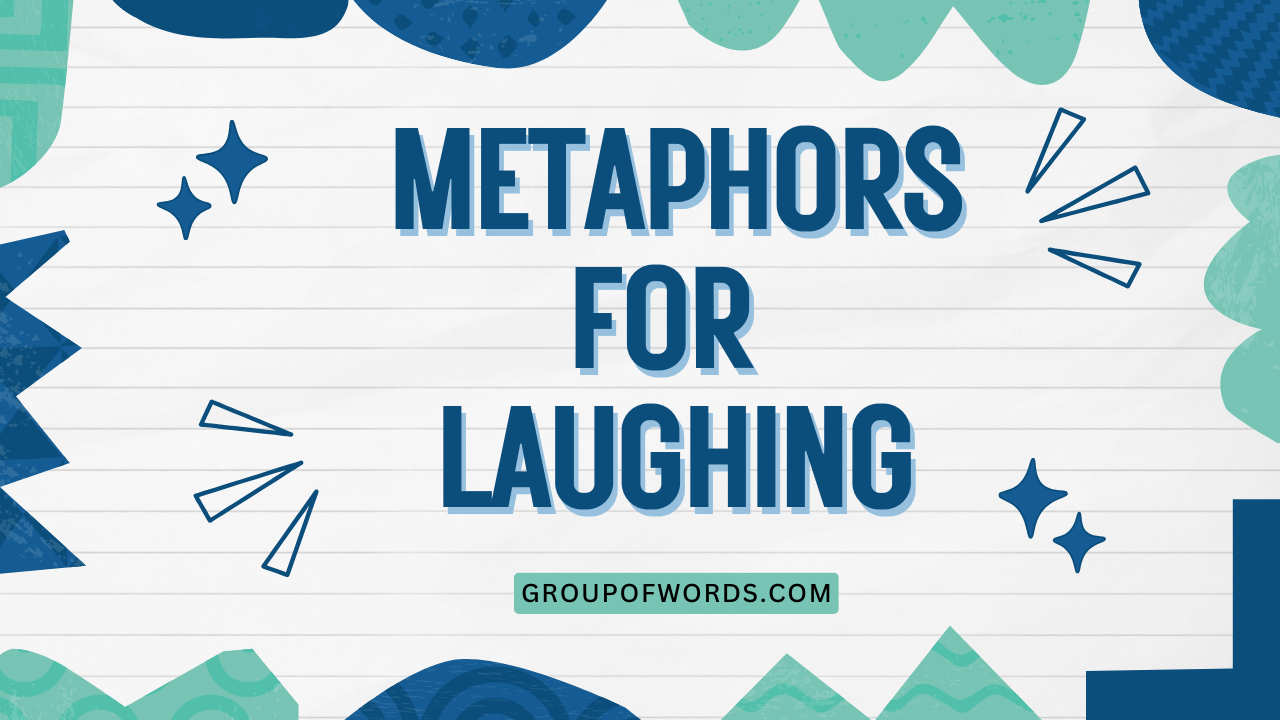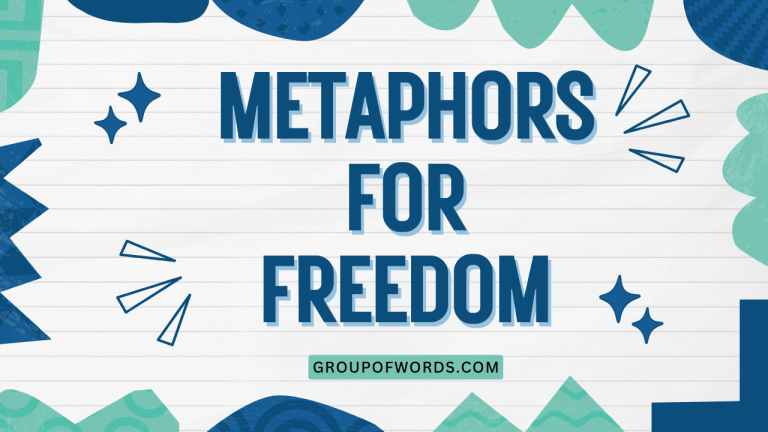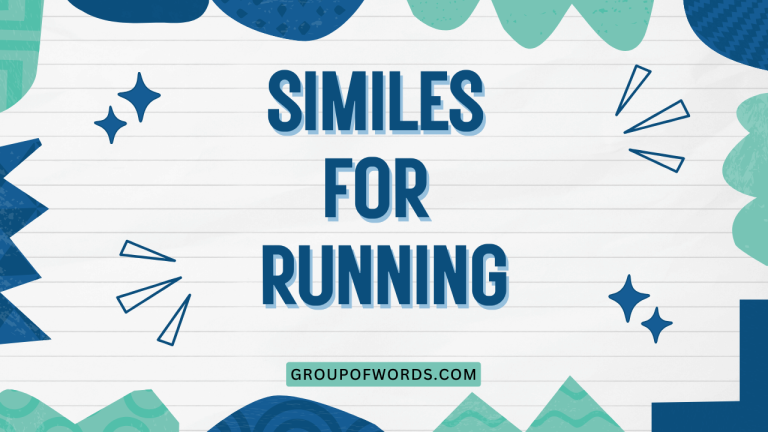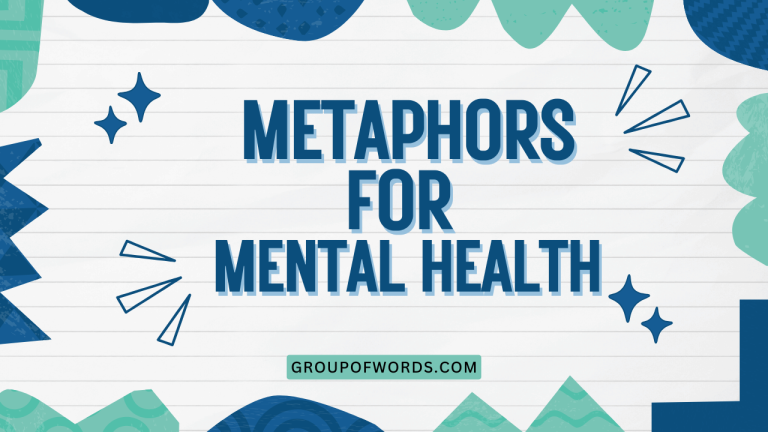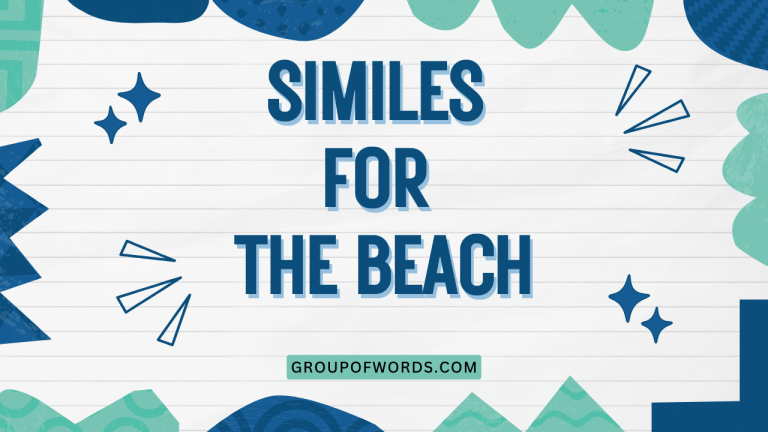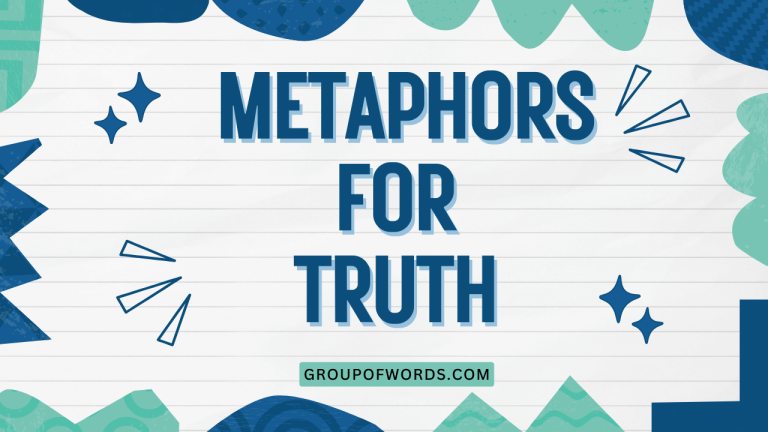Laughing Matters: Exploring Metaphors for Laughter
Laughter is a universal human experience, yet capturing its essence in words can be surprisingly challenging. Metaphors offer a powerful tool for vividly describing laughter, going beyond simple descriptions to convey its intensity, sound, and emotional impact.
Understanding these metaphors enriches our comprehension of English, particularly in literature and everyday conversation. This article delves into the diverse world of metaphors for laughter, exploring their meanings, structures, and usage.
This guide is perfect for English language learners, writers, and anyone interested in the nuances of language.
Table of Contents
- Introduction
- Definition of Metaphors for Laughter
- Structural Breakdown
- Types and Categories of Laughter Metaphors
- Examples of Metaphors for Laughter
- Usage Rules
- Common Mistakes
- Practice Exercises
- Advanced Topics
- FAQ
- Conclusion
Introduction
Laughter is a fundamental part of the human experience, a spontaneous expression of joy, amusement, or even nervousness. Describing laughter effectively requires more than just stating that someone laughed.
Metaphors provide a rich and nuanced way to convey the characteristics of laughter, painting vivid pictures in the reader’s mind. By understanding and using metaphors for laughter, we can add depth and color to our writing and speech, making our communication more engaging and impactful.
This article will explore the various types of metaphors used to describe laughter, providing examples, usage rules, and practice exercises to help you master this aspect of the English language.
Definition of Metaphors for Laughter
A metaphor is a figure of speech that directly compares two unrelated things, asserting that one thing is another, to highlight a shared quality or characteristic. In the context of laughter, metaphors are used to describe the act or sound of laughing in terms of something else, creating a more vivid and imaginative depiction. These metaphors can focus on the sound of laughter (e.g., “laughter like tinkling bells”), the physical manifestation (e.g., “laughter that shook his whole body”), or the emotional impact (e.g., “laughter that warmed the room”). The function of these metaphors is to enhance the reader’s or listener’s understanding and experience of the laughter being described. They add depth, color, and emotional resonance to the language.
Metaphors for laughter can be classified based on what aspect of laughter they emphasize. They can describe the sound, the physical actions associated with laughter, the emotional effect the laughter has, or even the appearance of the person laughing.
The context in which the metaphor is used is crucial for understanding its intended meaning. A metaphor describing laughter as “a roaring fire” evokes a different image and feeling than one describing it as “a gentle stream.” Therefore, understanding the different types of metaphors and their specific connotations is essential for effective communication.
Structural Breakdown
Metaphors for laughter, like all metaphors, typically follow a simple structure: A is B. In this case, A is the laughter, and B is something else that shares a characteristic with the laughter being described.
The effectiveness of the metaphor depends on the strength of the connection between A and B and the vividness of the image it creates. Consider the metaphor “Her laughter was a ray of sunshine.” Here, ‘laughter’ (A) is being compared to ‘a ray of sunshine’ (B).
The shared characteristic is brightness and warmth. The metaphor suggests that her laughter is cheerful, uplifting, and brings light into the situation.
The structure can be expanded with adjectives and adverbs to add further detail and nuance. For example, “Her infectious laughter was like a warm, golden ray of sunshine.”
The structure can also be more implicit. Instead of directly stating “Laughter is X,” the metaphor can be embedded within a sentence, allowing the comparison to be inferred.
For example, “His voice bubbled with laughter” implies that his laughter is like bubbles, suggesting lightness, effervescence, and perhaps a sense of uncontrolled joy. Understanding this basic structure allows you to both analyze existing metaphors and create your own, tailoring them to precisely convey the desired effect.
Types and Categories of Laughter Metaphors
Metaphors for laughter can be categorized based on the aspect of laughter they emphasize. Here are some common categories:
Auditory Metaphors
These metaphors focus on the sound of laughter, often comparing it to musical instruments, natural sounds, or other noises. They aim to capture the tone, pitch, and rhythm of the laughter.
Auditory metaphors are particularly effective in conveying the quality and intensity of the laughter.
Physical Metaphors
Physical metaphors describe the physical actions associated with laughter, such as shaking, trembling, or facial expressions. These metaphors highlight the physical impact of laughter on the body.
They can convey the forcefulness and unrestrained nature of the laughter.
Emotional Metaphors
Emotional metaphors focus on the feelings and emotions associated with laughter. They describe the effect the laughter has on oneself or others, such as joy, warmth, or relief.
These metaphors emphasize the emotional impact and significance of the laughter.
Visual Metaphors
Visual metaphors create a visual image of the laughter, often comparing it to light, color, or movement. These metaphors help the reader visualize the laughter and its impact on the environment or the person laughing.
They can add a sense of vibrancy and energy to the description.
Animalistic Metaphors
Animalistic metaphors compare laughter to the sounds or behaviors of animals. These metaphors can be used to convey the wild, untamed, or primal nature of laughter.
They often evoke strong imagery and can be used to express both positive and negative connotations of laughter.
Examples of Metaphors for Laughter
The following tables provide numerous examples of metaphors for laughter, categorized by type.
Table 1: Auditory Metaphors for Laughter
This table illustrates how laughter can be described using auditory metaphors, comparing it to various sounds and musical elements.
| Metaphor | Explanation |
|---|---|
| Her laughter was like tinkling bells. | Suggests a light, clear, and musical quality to the laughter. |
| His laughter echoed like thunder. | Conveys a loud, powerful, and resonant laughter. |
| Her laughter was a melody. | Implies a harmonious and pleasing sound. |
| His laughter was a cacophony. | Suggests a loud, jarring, and unpleasant sound. |
| Her laughter rang out like a joyous trumpet. | Conveys a loud, clear, and celebratory sound. |
| His laughter was a low rumble. | Suggests a deep, quiet, and suppressed sound. |
| Her laughter was a series of chirps. | Implies a light, quick, and bird-like sound. |
| His laughter was a booming roar. | Conveys a loud, forceful, and unrestrained sound. |
| Her laughter was a soft whisper. | Suggests a quiet, gentle, and intimate sound. |
| His laughter was a sharp crack. | Implies a sudden, loud, and startling sound. |
| Her laughter cascaded like a waterfall. | Suggests a continuous, flowing, and abundant sound. |
| His laughter was a muffled chuckle. | Conveys a quiet, suppressed, and self-amused sound. |
| Her laughter chimed like wind chimes. | Implies a delicate, airy, and pleasant sound. |
| His laughter vibrated like a bass drum. | Conveys a deep, resonant, and powerful sound. |
| Her laughter was a peal of joy. | Suggests a loud, ringing, and celebratory sound. |
| His laughter was a grating screech. | Implies an unpleasant, harsh, and irritating sound. |
| Her laughter trilled like a bird’s song. | Conveys a melodious, high-pitched, and cheerful sound. |
| His laughter resonated through the room. | Suggests a deep, full, and pervasive sound. |
| Her laughter was a tinkling stream. | Implies a light, clear, and flowing sound. |
| His laughter was a guttural bellow. | Conveys a deep, rough, and animalistic sound. |
| Her laughter was a silvery chime. | Suggests a bright, clear, and delicate sound. |
| His laughter echoed off the walls. | Implies a loud and reverberating sound. |
| Her laughter was music to my ears. | Conveys a pleasing and delightful sound. |
Table 2: Physical Metaphors for Laughter
This table presents examples of physical metaphors, describing the physical sensations and actions associated with laughter.
| Metaphor | Explanation |
|---|---|
| Laughter shook his whole body. | Conveys the intense physical impact of laughter. |
| Tears streamed down her face from laughter. | Suggests uncontrollable, joyous laughter. |
| He doubled over with laughter. | Implies laughter so intense it caused physical bending. |
| Laughter bubbled up from her chest. | Suggests a light, effervescent, and uncontrollable laughter. |
| His sides ached from laughter. | Conveys the physical strain of prolonged laughter. |
| She gasped for air between bursts of laughter. | Implies laughter so intense it interfered with breathing. |
| Laughter danced in her eyes. | Suggests a light, joyful, and expressive laughter. |
| His face was contorted with laughter. | Conveys the extreme physical expression of laughter. |
| She clutched her stomach, laughing. | Implies laughter so intense it caused physical discomfort. |
| He was convulsed with laughter. | Suggests a violent, uncontrollable, and physical reaction to laughter. |
| Her body trembled with laughter. | Conveys the physical vibration caused by intense laughter. |
| His cheeks flushed with laughter. | Implies a physical response to joyous or embarrassing laughter. |
| She wiped tears of laughter from her eyes. | Suggests laughter so intense it caused tears. |
| He choked on his laughter. | Conveys a sudden, suppressed, and potentially painful reaction to laughter. |
| Her shoulders shook with silent laughter. | Implies suppressed but still physically evident laughter. |
| His face crumpled with laughter. | Suggests a physical expression of unrestrained laughter. |
| She slapped her knee, laughing. | Conveys a spontaneous and physical reaction to laughter. |
| He threw his head back and roared with laughter. | Implies a loud, unrestrained, and physically expressive laughter. |
| Her eyes sparkled with laughter. | Suggests a joyful, animated, and expressive laughter. |
| His whole frame vibrated with laughter. | Conveys the intense physical impact of laughter throughout the body. |
| She nearly fell off her chair laughing. | Implies laughter so intense it caused physical instability. |
| He sputtered with laughter. | Conveys a spluttering sound produced by laughter. |
| Her laughter rippled through her body. | Suggests a wave-like motion caused by laughter. |
Table 3: Emotional Metaphors for Laughter
This table provides examples of emotional metaphors, describing the feelings and emotions associated with laughter.
| Metaphor | Explanation |
|---|---|
| Her laughter warmed the room. | Conveys the positive, comforting, and welcoming effect of her laughter. |
| His laughter was a ray of sunshine. | Suggests a bright, cheerful, and uplifting quality to his laughter. |
| Her laughter chased away the shadows. | Implies that her laughter dispelled negativity and sadness. |
| His laughter was a balm to her soul. | Conveys the soothing, healing, and comforting effect of his laughter. |
| Her laughter was infectious. | Suggests that her laughter spread easily and made others laugh. |
| His laughter was a burst of joy. | Implies a sudden, intense, and unrestrained expression of happiness. |
| Her laughter was a welcome escape. | Conveys that her laughter provided a temporary relief from stress or problems. |
| His laughter was a lifeline. | Suggests that his laughter provided support, hope, and connection during a difficult time. |
| Her laughter was a beacon of hope. | Implies that her laughter was a source of inspiration, optimism, and guidance. |
| His laughter was a bridge between them. | Conveys that his laughter created a bond, connection, and understanding between people. |
| Her laughter was a celebration of life. | Suggests that her laughter was an expression of joy, gratitude, and appreciation for life. |
| His laughter was a shield against sorrow. | Implies that his laughter protected him from sadness and negativity. |
| Her laughter was a gift. | Conveys that her laughter was a precious, valuable, and appreciated offering. |
| His laughter was a spark of happiness. | Suggests that his laughter ignited joy and positivity in others. |
| Her laughter was a comforting embrace. | Implies that her laughter provided warmth, security, and reassurance. |
| His laughter was a gentle reminder of joy. | Conveys that his laughter prompted others to remember and appreciate happiness. |
| Her laughter was a source of strength. | Suggests that her laughter provided resilience, courage, and determination. |
| His laughter was a shared secret. | Implies that his laughter created a sense of intimacy, understanding, and connection. |
| Her laughter was a reminder of simpler times. | Conveys that her laughter evoked nostalgia, innocence, and fond memories. |
| His laughter was a moment of pure bliss. | Suggests that his laughter created a state of perfect happiness and contentment. |
| Her laughter dissolved the tension in the room. | Implies that her laughter alleviated stress, anxiety, and discomfort. |
| His laughter painted the air with joy. | Conveys that his laughter filled the atmosphere with happiness and delight. |
| Her laughter was the sweetest sound he knew. | Suggests that her laughter was the most cherished and pleasing sound to him. |
Table 4: Visual Metaphors for Laughter
This table presents examples of visual metaphors, creating a visual image of the laughter and its effects.
| Metaphor | Explanation |
|---|---|
| Laughter lit up her face. | Conveys that her laughter made her face radiant and bright. |
| His laughter painted the air with joy. | Suggests that his laughter filled the atmosphere with happiness and delight. |
| Her laughter sparkled in her eyes. | Implies that her eyes shone with joy and amusement. |
| His laughter was a spotlight on the moment. | Conveys that his laughter drew attention to and highlighted the importance of the moment. |
| Her laughter was a kaleidoscope of colors. | Suggests that her laughter was vibrant, diverse, and ever-changing. |
| His laughter was a sunbeam breaking through the clouds. | Implies that his laughter brought light and warmth to a gloomy situation. |
| Her laughter was a dance of light and shadow. | Conveys that her laughter was complex, playful, and nuanced. |
| His laughter was a fountain of joy. | Suggests that his laughter was abundant, overflowing, and refreshing. |
| Her laughter was a prism refracting light. | Implies that her laughter transformed the ordinary into something beautiful and complex. |
| His laughter was a shooting star across the night sky. | Conveys that his laughter was fleeting, brilliant, and memorable. |
| Her laughter was a blossoming flower. | Suggests that her laughter was beautiful, delicate, and full of life. |
| His laughter was a sunrise over the horizon. | Implies that his laughter brought hope, optimism, and a new beginning. |
| Her laughter was a shimmering pool. | Conveys that her laughter was calm, reflective, and inviting. |
| His laughter was a firework exploding with joy. | Suggests that his laughter was explosive, vibrant, and celebratory. |
| Her laughter was a rainbow after the storm. | Implies that her laughter brought beauty and hope after a difficult time. |
| His laughter was a beacon in the darkness. | Conveys that his laughter provided guidance, hope, and safety in a challenging situation. |
| Her laughter was a swirling vortex of energy. | Suggests that her laughter was powerful, captivating, and transformative. |
| His laughter was a cascade of stars. | Implies that his laughter was abundant, dazzling, and magical. |
| Her laughter was a painting come to life. | Conveys that her laughter transformed the scene into something beautiful and vibrant. |
| His laughter was a spotlight illuminating the room. | Suggests that his laughter brightened the atmosphere and drew attention to the moment. |
| Her laughter was a mirage in the desert. | Implies that her laughter was a welcome illusion, offering temporary relief and hope. |
Table 5: Animalistic Metaphors for Laughter
This table provides examples of animalistic metaphors, comparing laughter to the sounds and behaviors of animals.
| Metaphor | Explanation |
|---|---|
| His laughter was a donkey’s bray. | Conveys a loud, harsh, and somewhat unpleasant laughter. |
| Her laughter was a bird’s trill. | Suggests a light, melodious, and cheerful laughter. |
| His laughter was a hyena’s cackle. | Implies a sinister, mocking, and unsettling laughter. |
| Her laughter was a kitten’s purr. | Conveys a soft, gentle, and comforting laughter. |
| His laughter was a lion’s roar. | Suggests a loud, powerful, and commanding laughter. |
| Her laughter was a puppy’s yelp. | Implies a high-pitched, excited, and playful laughter. |
| His laughter was a frog’s croak. | Conveys a deep, rough, and guttural laughter. |
| Her laughter was a dove’s coo. | Suggests a gentle, peaceful, and soothing laughter. |
| His laughter was a wolf’s howl. | Implies a wild, unrestrained, and perhaps mournful laughter. |
| Her laughter was a cricket’s chirp. | Conveys a light, quick, and repetitive laughter. |
| His laughter was a bear’s growl. | Suggests a low, rumbling, and potentially threatening laughter. |
| Her laughter was a bee’s buzz. | Implies a busy, active, and energetic laughter. |
| His laughter was an owl’s hoot. | Conveys a deep, resonant, and somewhat mysterious laughter. |
| Her laughter was a lamb’s bleat. | Suggests a soft, innocent, and vulnerable laughter. |
| His laughter was a peacock’s screech. | Implies a loud, showy, and perhaps ostentatious laughter. |
| Her laughter was a squirrel’s chatter. | Conveys a quick, lively, and incessant laughter. |
| His laughter was a serpent’s hiss. | Suggests a sinister, sly, and potentially dangerous laughter. |
| Her laughter was a canary’s warble. | Implies a melodious, cheerful, and captivating laughter. |
| His laughter was a boar’s grunt. | Conveys a rough, uncouth, and perhaps aggressive laughter. |
| Her laughter was a butterfly’s flutter. | Suggests a light, delicate, and fleeting laughter. |
Usage Rules
When using metaphors for laughter, it’s important to consider the context and the intended effect. The metaphor should be appropriate for the situation and the tone of the writing.
Choose metaphors that resonate with your audience and effectively convey the desired image or feeling. Avoid clichés and overused metaphors, as they can weaken the impact of your writing.
Instead, strive to create original and imaginative metaphors that will capture the reader’s attention.
Ensure that the comparison between the laughter and the metaphorical element is logical and meaningful. The shared characteristic should be clear and relevant.
Also, be mindful of the connotations of the metaphorical element. For example, comparing laughter to a “hyena’s cackle” might convey a negative or sinister impression, while comparing it to “tinkling bells” suggests a more positive and lighthearted feeling.
Furthermore, use metaphors sparingly and strategically. Overusing metaphors can make your writing sound forced or unnatural.
Choose the most impactful moments to employ metaphors and let the rest of your writing speak for itself.
Common Mistakes
One common mistake is using mixed metaphors, where the comparison becomes illogical or confusing. For example: “Her laughter was a ray of sunshine that cut like a knife.” This mixes the positive image of sunshine with the negative image of a knife, creating a jarring and nonsensical comparison.
Another mistake is using clichés or overused metaphors, such as “laughter is the best medicine.” While this phrase is widely understood, it lacks originality and impact. Strive to create fresh and imaginative metaphors that will capture the reader’s attention.
Consider the examples below:
| Incorrect | Correct |
|---|---|
| Her laughter was the best medicine. | Her laughter was a balm to my soul. |
| His laughter filled the room. | His laughter resonated through the room like thunder. |
| She laughed her head off. | She doubled over, tears streaming down her face, with laughter. |
Practice Exercises
Test your understanding of metaphors for laughter with the following exercises.
Exercise 1: Identifying Metaphors
Identify the metaphors for laughter in the following sentences.
| Question | Answer |
|---|---|
| 1. Her laughter was a cascade of sparkling water. | cascade of sparkling water |
| 2. His laughter painted joy on everyone’s faces. | painted joy |
| 3. The child’s laughter was a melody of pure delight. | melody of pure delight |
| 4. Her laughter chased away the storm clouds in his mind. | chased away the storm clouds |
| 5. His booming laughter was a thunderclap in the quiet room. | thunderclap |
| 6. Her giggle was a gentle stream of happiness. | gentle stream of happiness |
| 7. His laughter was a warm blanket on a cold day. | warm blanket |
| 8. Her infectious laughter was a virus that spread quickly. | virus |
| 9. His laughter was a beacon of hope in a dark time. | beacon of hope |
| 10. Her laughter was like wind chimes in a summer breeze. | wind chimes |
Exercise 2: Creating Metaphors
Complete the following sentences by creating your own metaphor for laughter.
| Question | Answer |
|---|---|
| 1. His laughter was like _______________. | His laughter was like a roaring bonfire on a cold night. |
| 2. Her laughter sounded like _______________. | Her laughter sounded like a flock of birds taking flight. |
| 3. The child’s laughter was _______________. | The child’s laughter was a pure, unfiltered joy. |
| 4. His deep laughter was _______________. | His deep laughter was a comforting rumble. |
| 5. Her nervous laughter was _______________. | Her nervous laughter was a fragile, tinkling glass. |
| 6. Their shared laughter was _______________. | Their shared laughter was a bridge between their hearts. |
| 7. The old man’s laughter was _______________. | The old man’s laughter was a treasure, earned over a lifetime. |
| 8. Her sudden laughter was _______________. | Her sudden laughter was a spark in the darkness. |
| 9. The villain’s laughter was _______________. | The villain’s laughter was a chilling echo in the empty hall. |
| 10. The comedian’s laughter was _______________. | The comedian’s laughter was a carefully crafted performance. |
Exercise 3: Matching Metaphors to Emotions
Match the following metaphors for laughter to the emotions they best represent.
| Metaphor | Emotion |
|---|---|
| 1. His laughter was a hyena’s cackle. | A. Mockery |
| 2. Her laughter was a kitten’s purr. | B. Contentment |
| 3. His laughter was a lion’s roar. | C. Confidence |
| 4. Her laughter was a bird’s trill. | D. Joy |
| 5. His laughter was a nervous cough. | E. Anxiety |
| 6. Her laughter was a soft whisper. | F. Intimacy |
Answers: 1-A, 2-B, 3-C, 4-D, 5-E, 6-F
Advanced Topics
For advanced learners, exploring the use of extended metaphors and allegories related to laughter can provide a deeper understanding of the topic. An extended metaphor is a metaphor that is developed over several lines or sentences, creating a more complex and nuanced comparison.
An allegory is a story or narrative in which the characters and events represent abstract ideas or moral qualities. Analyzing literary works that employ these techniques can enhance your appreciation for the power of metaphor in conveying meaning and emotion.
Consider the use of irony and satire in relation to laughter metaphors. Sometimes laughter is used metaphorically to represent something other than joy or amusement, such as ridicule, scorn, or even despair.
Understanding these more complex and subtle uses of metaphor can elevate your command of the English language. For example, in some literary contexts, describing someone’s laughter as “hollow” or “empty” might be a metaphor for their lack of genuine emotion or their inner turmoil.
FAQ
Here are some frequently asked questions about metaphors for laughter.
- What is the difference between a metaphor and a simile?
A metaphor directly compares two unrelated things, stating that one thing is another. A simile, on the other hand, uses “like” or “as” to make a comparison. For example, “Her laughter was sunshine” is a metaphor, while “Her laughter was like sunshine” is a simile.
- Why use metaphors for laughter instead of literal descriptions?
Metaphors add depth, color, and emotional resonance to your writing. They help the reader or listener visualize and experience the laughter more vividly than a literal description would. They make the language more engaging and memorable.
- How can I avoid using clichés when creating metaphors for laughter?
Think outside the box and try to come up with original comparisons that haven’t been used before. Consider the specific qualities of the laughter you’re describing and look for unusual or unexpected connections. Read widely and pay attention to how other writers use metaphors effectively.
- What are some common categories of metaphors for laughter?
Common categories include auditory metaphors (describing the sound), physical metaphors (describing the physical actions), emotional metaphors (describing the feelings), visual metaphors (creating a visual image), and animalistic metaphors (comparing laughter to animal sounds or behaviors).
- How can I tell if a metaphor for laughter is effective?
An effective metaphor should be clear, concise, and evocative. It should create a vivid image or feeling in the reader’s mind and enhance their understanding of the laughter being described. It should also be appropriate for the context and tone of the writing.
- Is it possible to overuse metaphors for laughter?
Yes, overusing metaphors can make your writing sound forced or unnatural. Use metaphors sparingly and strategically, choosing the most impactful moments to employ them. Let the rest of your writing speak for itself.
- Can metaphors for laughter be negative or critical?
Yes, metaphors for laughter can be used to convey negative emotions or critical judgments. For example, describing someone’s laughter as a “hyena’s cackle” suggests a mocking or sinister quality.
- How do cultural differences affect the interpretation of metaphors for laughter?
Cultural differences can influence the connotations and associations of certain metaphors. What might be considered a positive or humorous comparison in one culture could be interpreted differently in another. Be mindful of your audience and choose metaphors that are likely to resonate with them.
Conclusion
Mastering the art of using metaphors for laughter can significantly enhance your writing and communication skills. By understanding the different types of metaphors, their structures, and usage rules, you can add depth, color, and emotional resonance to your language.
Remember to avoid clichés, consider the context, and choose metaphors that effectively convey the desired image or feeling. Practice creating your own metaphors and analyzing those used by other writers.
With time and effort, you can become proficient in using metaphors to describe laughter in a vivid and imaginative way.
The key takeaways from this article include the importance of understanding the different categories of laughter metaphors (auditory, physical, emotional, visual, and animalistic), the need to avoid common mistakes such as mixed metaphors and clichés, and the value of practicing creating your own metaphors. By applying these principles, you can elevate your writing and communication skills and express yourself with greater clarity and impact.
Keep exploring the nuances of language, and you’ll continue to grow as a writer and communicator.
